Abstract
Severe haze events have many adverse effects on agricultural production and human activity. Haze events are often associated with specific patterns of atmospheric circulation. Therefore, studying the relationship between atmospheric circulation and haze is particularly important for early warning and forecasting of urban haze events. In order to study the relationship between multi-scale atmospheric circulation and severe haze events in autumn and winter in Shanghai, China, we used a T-mode objective classification method to classify autumn and winter atmospheric circulation patterns into six types based on sea level pressure data from 2007 to 2016 in the Shanghai area. For the period between September 2016 and February 2017, we used the Allwine–Whiteman method to classify the local wind in Shanghai into three categories: stagnation, recirculation, and ventilation. By further studying the PM2.5 concentration distribution, visibility distribution, and other meteorological characteristics of each circulation type (CT) and local wind field type, we found that the Shanghai area is most prone to severe haze when exposed to certain circulation patterns (CT1, CT2, and CT4), mainly associated to the cold air activity and the displacement of the high pressure system relative to Shanghai. We also found that the local wind fields in the Shanghai area are dominated by recirculation and stagnation events. These conclusions were further verified by studying a typical pollution process in Shanghai in November 2016 and the pollutant diffusion path using the HYSPLIT (Hybrid Single Particle Lagrangian Integrated Trajectory model) simulation model.
1. Introduction
Haze is a weather phenomenon that occurs when the aerosol system, which is composed of particles, such as dust, sulfuric acid, and nitric acid floating in the air, is subject to relatively stable weather conditions [1,2,3]. Haze directly affects agricultural production and human quality of life, namely, through the effective reduction of visibility, by blocking solar radiation and inhibiting plant photosynthesis [4,5,6,7]. Haze can additionally pose more immediate threats to human health through skin irritation, respiratory diseases, and related conditions, which can be life-threatening [8,9,10,11,12]. In China alone, up to 1.37 million deaths in 2016 resulted from the inhalation of excessive particulate matter [13]. Given the widespread concern associated with urban haze, research on severe haze in cities is of vital importance.
As one of China’s largest cities, Shanghai has experienced rapid economic development, urban expansion, and population expansion over the past three decades, which have been accompanied by an increase in haze incidence in the region [14,15]. Although air quality has significantly improved in recent years owing to government intervention at all levels, haze remains an important factor affecting air quality in the region [16,17].
The main cause of haze is the high concentration of particulate matter in the atmosphere [18]. Stable atmospheric stratification conditions are necessary for haze to form. Therefore, in Shanghai severe haze is most common in the autumn and winter, during which the atmosphere is relatively stable. This pattern has been exacerbated by the large quantity of dust particles generated by the burning of bituminous coal in the northern China region during autumn and winter; these particles have dispersed to the Shanghai area with the spread of cold air [15]. Therefore, studying the relationship between atmospheric circulation and severe haze events in autumn and winter is of great importance for early forecasting of severe haze in Shanghai.
There have been many studies on the relationship between atmospheric circulation and urban haze in China and other countries. Zhang et al. [19,20] studied the weather background of a severe haze event in January 2013 in eastern China and found that the stability of the bottom atmosphere and adequate moisture transport led to the occurrence of this severe haze event. Bei et al. [21]. used the subjective circulation classification method to study the relationship between haze and weather circulation in the Guanzhong region in China in winter and found that haze is related to certain circulation patterns. Similarly, Zheng et al. [22] studied the influence of weather circulation, regional transmission, and heterogeneous reactions on severe haze in Beijing, China, in the winter of 2012–2013, and found that such haze events were associated with specific circulation types and that regional transmission contributed greatly to haze accumulation.
Classification of circulation weather systems have a long history, and, in recent years, the usefulness of circulation weather type (CWT) classifications has been demonstrated widely in a variety of applications, namely, in (i) climatic variability and climate applications [23,24,25], including trends and extreme years, and in (ii) environmental [7,26] and (iii) weather driven natural hazards [27,28]. The CWT provide a discrete characterization of the atmospheric conditions for a specific given region. Over the last decades, the classification of CWT has witnessed a growing development and application, being extremely useful for gaining insight into the atmospheric processes at the synoptic scale, but also for studying the relationship between atmospheric circulation and surface climate variability [25]. The classification of CWT can be made through very different procedures which can be based on the application of statistical selection rules or on the determination of physical parameters related with the prevailing atmospheric circulation pattern [29]. McGregor and Bamzelis [30] used K cluster analysis to classify weather circulation and studied the relationship between air quality and weather-scale systems in Birmingham, England. They found that continental high pressure caused haze events, whereas oceanic cyclone control did not have a strong effect. Jiang et al. [31] analyzed the dependence of regional meteorological elements and nitrogen oxide concentration on synoptic-scale circulation in Auckland, New Zealand, using a method that combined T-mode PCA and K-means. The results showed that under the control of two high-pressure systems, mornings in this region were characterized by low wind, low temperature, and high relative humidity (RH) which corresponded to severe haze events. Good air quality was associated with strong southwest winds, which are associated with good diffusion conditions.
Atmospheric circulation includes large-scale (weather-scale) circulation and medium- and small-scale local circulation [32]. Local circulation is often expressed in terms of the local wind field. Circulation at the weather scale determines the dynamic background for atmospheric circulation, while providing power for local circulation. However, local circulation is affected by topography, buildings, ground vegetation, and even human activities, and directly acts on the diffusion of pollutants, providing direct dynamic conditions for the diffusion of particles and determining the speed and intensity of diffusion. Therefore, when studying haze, the combined effects of large- and meso-scale weather circulation should be considered together.
This work’s main goal was to analyze the relationship between multi-scale atmospheric circulation and severe haze events in autumn and winter in Shanghai, China. In order to accomplish the proposed goal, a T-mode objective classification method was used to classify CWT based on sea level pressure data from 2007 to 2016 in the Shanghai area. Local circulation was classified through the Allwine–Whiteman method in terms of stagnation, recirculation, and ventilation. Finally, an extreme haze event was analyzed.
2. Data and Methods
2.1. Meteorological and Air Quality Data
2.1.1. Sea Level Pressure Data
The mean sea level pressure (SLP) data used in the present study to classify the daily circulation type were derived from reanalyzed data from the National Centers for Environmental Prediction [33] with a horizontal resolution of 1° × 1° for the years 2007 to 2016 (September to February each year) and for the area ranging from 30° N–33° N, 118° E–123° E. The data were sampled four times per day: 00:00, 06:00, 12:00, and 18:00 UTC. Among them, the 00:00 UTC timepoint was considered to encompass more data, so the 00:00 UTC pressure data were used to determine daily circulation type.
2.1.2. Local Meteorological Data
Hourly ground observation data, including wind direction, wind speed, temperature, dew point temperature, relative humidity (RH), and visibility, were sampled between September 2016 and February 2017 at Shanghai Baoshan (BS) Station. The BS Station is located in north Shanghai (121.45° E, 31.40° N) and is equipped with instruments, such as an advanced wind sensor, ultraviolet sensor, dual-band cloud automatic observer, and temperature and humidity sensors, to accurately measure the meteorological elements in Shanghai. After acquisition and rigorous processing, the observation data can be used for global observation data exchange with high accuracy and reliability.
2.1.3. Air Quality Data
Real-time air pollution data were downloaded from the website of the China National Environmental Monitoring Center [34]. The Environmental Monitoring Center of the Ministry of Environmental Protection of China has established more than 1000 real-time monitoring stations for air quality throughout the country. The stations are placed in representative locations in the suburbs and urban areas of each city monitored. These stations record local air-quality parameters once every hour. Observation records are released after quality control checks by the Ministry of Environmental Protection Air Quality Monitoring Center. Therefore, the data can accurately and comprehensively reflect the real-time air quality status of a particular area. Hourly observation data of inhalable particulate matter (PM2.5) from 10 monitoring stations in Shanghai from September 2016 to February 2017 were obtained. Table 1 shows the specific coordinates of these 10 monitoring stations. The specific location and altitude of each station are shown in Figure 1.

Table 1.
Location details of 10 real-time monitoring stations in Shanghai, China.
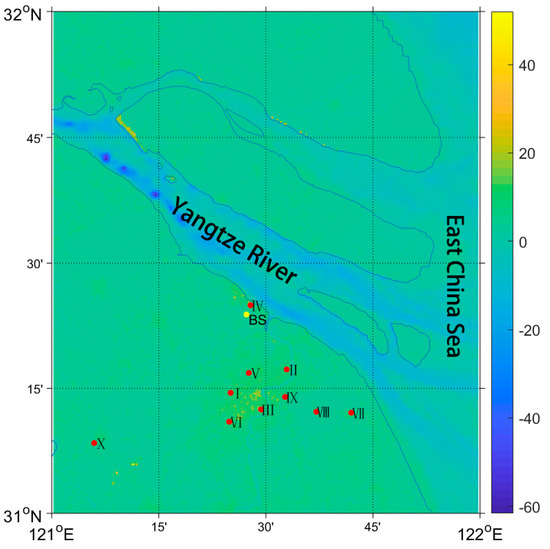
Figure 1.
Location of the 10 real-time monitoring stations (red dots) and the Baoshan meteorological observation station (yellow dot) in Shanghai, China.
2.2. Classification of Circulation Patterns
Circulation patterns are often determined using sea level pressure, geopotential heights, or wind fields (regular grids) [35]. Because circulation at the synoptic scale strongly influences the transmission and diffusion of pollutants, classification based on circulation is more suitable for determining weather patterns. It was necessary to objectively classify the circulation patterns in the Shanghai area to evaluate the relationship between circulation and air quality. We used the T-model method [36] and sea level pressure data from the Shanghai area from September 2007 to February 2016 to classify circulation patterns. The input data matrix for this method was two-dimensional and consisted of spatiotemporal data [37]. The principal component analysis (PCA) plot was tilted and rotated to obtain a more optimal solution [38,39]. Therefore, the classification results had better stability and repeatability for the main circulation pattern and could better avoid the “snowball” effect commonly resulting from other classification methods (i.e., a single pattern being overrepresented in the model). The model program can be obtained from the COST733 website [40,41].
2.3. Classification of Local Wind Field
We used the Allwine–Whiteman (AW) method and hourly wind direction observation data from the BS Station to calculate the recirculation index (R) of the Shanghai area and divided the local wind field of the Shanghai area from September 2016 to February 2017 into three categories: stagnation, recirculation, and ventilation. The AW method is an objective local horizontal wind field classification method proposed by Allwine and Whiteman [42]. The advantage of this method is that only the horizontal wind field is considered, and the vertical motion of the atmosphere is neglected. Therefore, only the hourly direction and speed of the wind are required, and the calculation is relatively simple. Some methods used by others [43,44] require detailed three-dimensional wind field data. Although the AW method does not accurately reflect atmospheric motion, it is still very effective when studying the horizontal diffusion of atmospheric pollutants. This method has been adopted by many authors [45,46,47,48,49] and comprises the following specific calculation steps:
Step 1: Decompose the hourly horizontal wind vector (Vi) into east–west (ui; east is positive) and north–south (vi; north is positive) components as follows:
Step 2: Calculate the daily R, S (total air displacement), and L (net air displacement) values, as follows:
where is the time interval of the data and τ is the total time. To calculate the values of L, S, and R for each day, we took and and converted the hourly wind speed unit to km/h. Thus, L represents the net distance that the air mass disengages from the measurement position after hours, i.e., net displacement. Similarly, S represents the total distance moved by the air mass during this time. As the surface winds were decomposed into east–west and north–south directions, R cannot be considered a true and accurate transmission measurement of air pollutants under actual conditions, especially in complex terrain where the wind field is not necessarily homogeneous [50]. A low R value indicates continuous wind direction at the ground level, but vertical recirculation cannot be ruled out [45]. Nevertheless, these indices can describe the diffusion conditions of the near-ground wind field in a simple and clear way. The R value ranges between 0 and 1, and a low R value indicates a continuous wind direction, whereas a high R value indicates changing wind direction.
Step 3: Determine the critical R, S, and L values for classifying the type of wind field. The present study used the improved critical values of the local wind field classification index following the approach by Russo et al. (2018) [51] for the Shanghai area, as follows:
The mean values of S and R over all periods were 230 km and 0.17, respectively. The 75th percentile value of S, the daily travel distance of the air mass, was 280 km, and the 25th percentile value of R, the daily return index, was 0.04.
2.4. Classification of Haze
The China Meteorological Administration divides haze events into three categories according to the influence of haze on air quality and visibility: moderate, serious, and severe haze. The corresponding standards are shown in Table 2.

Table 2.
Haze classification standards. RH, relative humidity.
3. Results and Discussion
3.1. Circulation Results
Using the T-PCA method, the main circulation patterns affecting the Shanghai area in autumn and winter were grouped into six types as shown in Figure 2. Circulation type 1 (CT1) was characterized by a high pressure on the northwest, and the Shanghai area was located within the cold high-pressure front. Circulation type 2 was characterized by a high pressure on the northwest, with a cyclone warm air mass west of Shanghai. Circulation type 3 was characterized by a high pressure gradually approaching the Shanghai area. Circulation type 4 was characterized by a high pressure in the west, with the Shanghai area located near the front of the high-pressure center. Circulation type 5 was characterized by a weak pressure field, with the cold air pressure-center approaching the Shanghai area. For CT6, the Shanghai area was in the rear of the high-pressure area, and the cold high-pressure center was located in the eastern sea; this is a typical circulation pattern after the passage of cold air. It can be seen from these six CTs that the weather system affecting Shanghai in the autumn and winter consisted mainly of cold air activity and by the displacement of the high-pressure system relative to Shanghai. Thus, each CT corresponds to different paths and locations of cold air relative to the Shanghai area. Table 3 gives the main characteristics and corresponding meteorological conditions of the six CTs. The meteorological characteristics are the mean values of observation data of Baoshan station under different circulation types in Shanghai, representing the average characteristics of the circulation type.
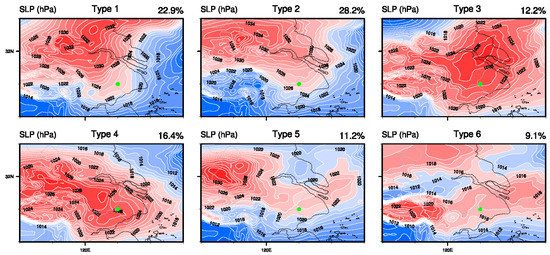
Figure 2.
The main circulation types during autumn and winter in Shanghai from 2007 to 2016 (green dot in each panel represents the location of Shanghai).

Table 3.
Characteristics and meteorological conditions of the six circulation types (CTs) defined in this study.
The humidity levels in the Shanghai area were generally low in autumn and winter (Table 3). The lowest and highest RH values were observed for CT4 (58%) and CT6 (76%), respectively. In addition, the average wind speed in Shanghai in autumn and winter is only 2–4 m/s. Figure 3 shows the wind roses for autumn and winter of 2016 in Shanghai. The highest frequencies of calm wind in Shanghai were observed for CT2 and CT4 (Figure 3), indicating that the local diffusion condition in Shanghai was poor under these two CTs. In addition, the average temperature recorded in the Shanghai area was also very low: 11.55 °C under CT2 and 5.8 °C under CT4.

Figure 3.
Wind roses for the 2016 autumn and winter seasons in Shanghai (the percentage above each wind rose indicates calm wind frequency). Wind speed was measured in m/s.
Figure 4 shows the monthly distribution of the six CTs. Shanghai is located in eastern China at the middle to high latitudes. It thus has a typical subtropical monsoon climate. Traditionally, September, October, and November are defined as autumn, and December, January, and February are defined as winter. Circulation type 6 mainly occurred during the autumn, whereas CT4 occurred only in winter (Figure 4). The other CTs also had seasonal patterns of occurrence, indicating that there were differences throughout the year in the cold air activity (e.g., position and intensity) around Shanghai.
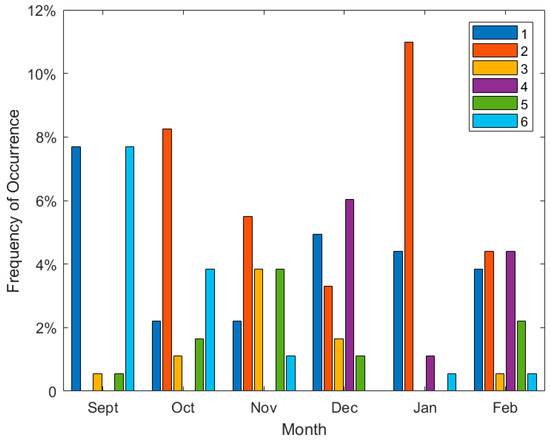
Figure 4.
Monthly distribution of circulation patterns (labeled 1–6) in Shanghai.
3.2. The Relationship between CTs and Local Wind Fields
According to the AW wind field classification method, the wind field in autumn and winter in Shanghai was divided into three categories: stagnation, recirculation, and ventilation. As shown in Figure 5, autumn and winter were dominated by stagnation and recirculation with stagnation and recirculation accounting for 60.44% and 32.42%, respectively. Circulation type 1, CT2, and CT6 were the dominant CTs during stagnation and recirculation days. Circulation type 1 was characterized by southeast winds with an average wind speed of 3.13 m/s, whereas CT2, CT3, and CT4 were characterized by east winds with average wind speeds of 2.71, 2.48, and 2.05 m/s, respectively (Figure 4). Circulation type 5 was characterized by east and northwest winds with an average wind speed of 2.50 m/s, whereas CT6 was characterized by northeast winds with an average wind speed of 2.16 m/s (Figure 4). Therefore, the overall diffusion conditions in Shanghai were poor and haze tended to occur in autumn and winter.
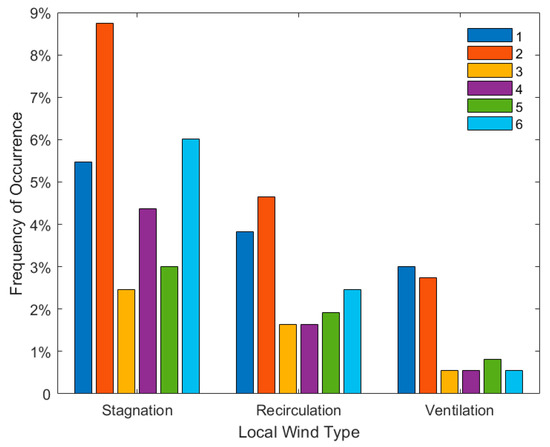
Figure 5.
Distribution of circulation patterns (labeled 1–6) among local wind field categories in Shanghai in 2016.
3.3. Associations between Circulation Patterns, Particulate Matter Concentration, and Visibility
Figure 6 shows the distribution of PM2.5 concentration and average visibility among the six CTs in Shanghai. The average PM2.5 concentration was highest under CT4, followed by CT1 and CT2 (Figure 6). Concentrations of PM2.5 in Shanghai were relatively low under CT6. Visibility levels followed an opposite trend. The lowest (highest) average visibility levels were observed for CT4 (CT6). This indicates that PM2.5 is an important determinant of visibility in Shanghai as they are predominantly concurrent and the cause of haze.
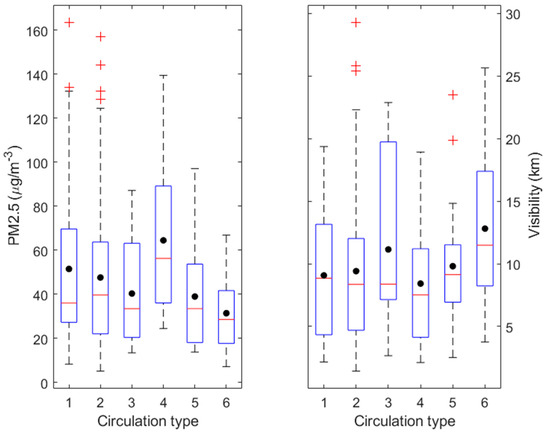
Figure 6.
Box and whisker plots of the visibility values and PM2.5 concentrations corresponding to six circulation types (CTs) in the autumn and winter of 2016. The dots represent mean values. The bottoms and tops of the dashed lines represent the values of the 5th and 95th percentiles, respectively; the lower sides of the rectangles represent the 25th percentile, the middle line represents the median, and the top lines represents the 75th percentile. The red signs denote the data beyond the mean values plus three times the standard deviation.
Table 4 shows the distributions of minimum visibility and maximum PM2.5 concentration in Shanghai among the six CTs. PM2.5 concentrations in Shanghai were generally high in autumn and winter, while visibility was poor, indicating that haze occurred commonly in autumn and winter. The average PM2.5 concentration in Shanghai only met the secondary standard (35 μg/m3) under CT6. By contrast, average PM2.5 concentrations under the other CTs exceeded the standard. In particular, average PM2.5 concentrations were high under CT1, CT2, and CT4, reaching values of 51.4, 47.5, and 64.4 μg/m3, respectively. The maximum PM2.5 concentration recorded was nearly 200 μg/m3. The trend in average visibility under the various CTs was basically inverse that of average PM2.5 concentrations. The highest average visibility in Shanghai (>12 km) was recorded under CT6, followed by CT3 (11 km). Circulation type 1, CT2, and CT4 were all associated with visibility <10 km. In particular, under CT4, the average visibility was only 8 km, and the minimum visibility was 928 m. This can be explained as under CT4, an anti-cyclonic center gradually approached Shanghai. As a result, the sinking airflow in front of the ground front stabilized the atmospheric layer in Shanghai, causing the accumulation of pollutant particles [7]. Under these conditions, maximum PM2.5 concentration and minimum visibility were observed, and severe haze was most likely to occur in the Shanghai area. The lowest values for the dewpoint (5.83 °C), RH (58.38%), average wind speed (2.05 m/s), and temperature (−1.88 °C) in Shanghai were also recorded under CT4 (Table 3). The average visibility under CT2 was slightly better than that under CT4, but the lowest minimum visibility among the six CTs was recorded under CT2 (6 m), indicating that extreme haze was likely to occur under this condition. The calm wind frequency in Shanghai area was highest under CT2 (2.15%); the wind direction was mainly east and northeast, and the wind speed was 2–3 m/s. The Shanghai area was also dominated by stagnation and recirculation wind fields under CT2.

Table 4.
Average and maximum PM2.5 concentration, and average and minimum visibility recorded for the six CTs examined in this study.
Under CT5, the average and maximum PM2.5 concentrations in Shanghai were not high, and the average visibility was close to 10 km. However, the minimum visibility was only 357 m, indicating that severe smog may occur in Shanghai when there is a weak pressure field. The average temperature in the Shanghai area was highest under CT6 (21.76 °C), corresponding to an RH of 76%. These represent typical autumn weather conditions, during which haze is mild and covers a relatively small area.
Table 5 shows the probability of occurrence and number of days of moderate, serious, and severe haze under the six CTs, as well as the number of days with stagnation, recirculation, or ventilation wind fields. Circulation type 1 accounted for the highest proportion of all severe haze days (41.2%), followed by CT2 and CT4 (35.3% and 11.8%, respectively). Circulation type 1 and CT2 accounted for the highest proportion of serious haze days (25.7% for both), and CT1, CT2, and CT4 accounted for the highest proportions of moderate haze days (31.3%, 40.6%, and 12.5%, respectively). Therefore, CT1, CT2, and CT4 are more likely to cause severe haze weather, whereas no severe haze in the Shanghai area occurred under CT6 (Figure 7).

Table 5.
The number of days haze occurred for each wind field type (Sta, stagnation; Ven, ventilation; Rec, recirculation) and for each haze standard (yellow, orange, and red), and the probability of haze occurrence (%) for each haze standard under the six CTs.

Figure 7.
The proportion of moderate, serious, and severe haze events corresponding to each of the six CTs.
3.4. The Relationship between Local Wind Fields and Particulate Matter Concentration and Visibility in Shanghai
Figure 8 shows the average PM2.5 concentration and visibility in Shanghai for the three wind field types. The lowest average PM2.5 concentration (30.13 μg/m3) and greatest visibility (11.3 km) were recorded for the ventilation wind field, indicating that ventilation wind field conditions are conducive to the dispersal of pollutants. The average and minimum visibility values corresponding to the stagnation wind field were 9.2 and 1.5 km, respectively. The average and maximum PM2.5 concentrations under the stagnation wind field were 55.15 and 163.46 μg/m3, respectively. The average and minimum visibility values recorded for the recirculation wind field were 8.3 and 1.4 km, respectively, and its average and maximum PM2.5 concentrations were 53.59 and 163.46 μg/m3, respectively. This indicates that the recirculation and stagnation wind fields are not conducive to the spread of pollutants and are likely to cause severe haze.
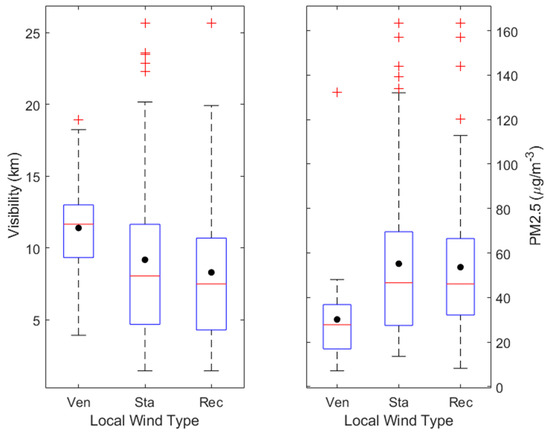
Figure 8.
Box and whisker plots of the visibility values and PM2.5 concentrations recorded for the ventilation (Ven), stagnation (Sta), and recirculation (Rec) wind fields in the autumn and winter of 2016. The dots represent mean values. The bottoms and tops of the dashed lines represent the values of the 5th and 95th percentiles, respectively; the lower sides of the rectangle represent the 25th percentile, the middle line represents the median, and the top lines represents the 75th percentile. The red signs denote the data beyond the mean values plus three times the standard deviation.
4. Analysis of the CTs and Wind Fields during a Severe Haze Event in Shanghai in November 2016
4.1. Haze Event Overview
At the beginning of November 2016, the Shanghai area experienced a severe haze event. Figure 9 shows the humidity, visibility, PM2.5, and temperature curves for the haze pollution event in Shanghai. The temperature and humidity exhibited significant diurnal fluctuations during the event—the temperature was low in the morning and evening and high at noon, whereas the humidity was high in the morning and evening and low at noon. The average wind speeds were low during the event, and clam winds were common (>70%). The wind fields in Shanghai were dominated by stagnation and recirculation patterns and had obvious characteristics of weather preceding a cold front.
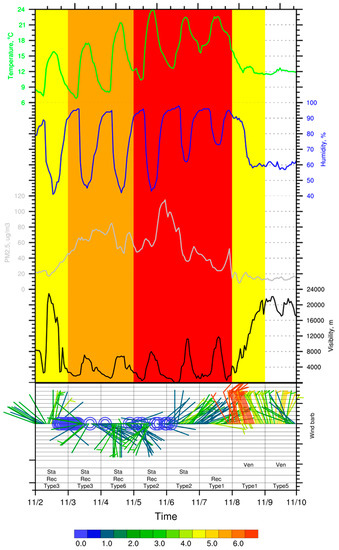
Figure 9.
The temperature, humidity, visibility, and PM2.5 concentration curves and the wind barb during the haze pollution event in Shanghai in November 2016. The yellow, orange, and red backgrounds represent periods of moderate, serious, and severe pollution, respectively. The circles in the wind barb represent a wind speed of 0 m/s.
It is noted that two obvious north–south surface wind transitions occurred from 2–5 November, with clear recirculation characteristics. The corresponding PM2.5 concentration increased from the 2nd to the 3rd and decreased slightly on the 4th and 5th before sharply increasing on the night of the 5th. In the early morning of 6 November, the PM2.5 concentration reached a maximum of 115 μg/m3 and the visibility deteriorated to 6 m. This caused the moderate haze to worsen and become a severe haze, which continued until the 7th, indicating that the recirculation wind field aggravated the haze. On the days of severe haze (5–7 November), the Shanghai area was experiencing the CT1 and CT2 patterns, which is consistent with the results discussed above (i.e., that CT1 and CT2 were associated with severe haze). On 8 November, the local wind field in Shanghai shifted to the ventilation type, and the speed of the north wind increased to >6 m/s. The CT also shifted from CT1 to CT5. Starting on the 8th, a cold front passed through the Shanghai area. There was significant cooling in the Shanghai area from the 8th onwards (Figure 9), and the RH declined continuously. The visibility quickly improved, and the severity of the haze event was reduced. This shows that in the autumn and winter, continuous low temperatures, low humidity, and northerly wind are conducive to ameliorate severe haze in Shanghai.
4.2. HYSPLIT (Hybrid Single Particle Lagrangian Integrated Trajectory Model) Model Simulation
Using the HYSPLIT model [52], the particle trajectories in the November 2016 pollution event were simulated backwards. The selected starting point was Shanghai (32° N, 121° E), using the default trajectory simulation type and Lambert projection. The starting time was 08:00 UTC on 6 November 2016 (00:00 Beijing time). At this moment, the PM2.5 concentration during the haze event was at its highest level (115 μg/m3), and the backward simulation was carried out for 144 h. The particle position was marked every 6 h to observe the pollutant propagation path and its origin, so as to analyze the cause of pollutant particle accumulation and the sharp increase in PM2.5 concentration. Three altitude levels were selected: 10 (ground level), 100, and 200 m. The calculation results are shown in Figure 10. The pollutants affecting Shanghai during the haze event came mainly from Tianjin and Hebei, north of Shanghai. The particles traveled south from the Tianjin and Hebei area on 31 October 2016 and arrived in the Shandong area on 2 November. In the autumn and winter, coal is burned in Tianjin and Hebei to meet the high demand for heating, generating large quantities of dust and other pollutants. During the day of 2 November, the pollutants moved southeast to the east China sea. In the early morning of the 3rd, the pollutants reached the sea area east of Shanghai, then moved in a curve southwest and arrived in Jiangsu Province on the 4th before moving northward. On the 5th, the pollutants reached the east Shanghai area. Their route then turned westward and progressed to the center of Shanghai on the 6th. The particles coming from the north of Shanghai mixed with local pollutants, causing severe haze. From the perspective of the particle movement path, the pollutants did not reach Shanghai directly from the north to the south but approached Shanghai from the south and east after a week of clockwise rotation above the East China Sea. This tortuous particle propagation path is a typical characteristic of the recirculation wind field, and the change in particle propagation direction seen in Figure 10 could have corresponded to the changes of the north–south wind barb between 2 November and 3 November and between 5 November and 6 November. Particles moved relatively quickly from 31 October to 3 November and greatly slowed down from 4 November to 6 November. In particular, on 5 November, particles only traveled approximately 50 km over the entire day, which corresponded to stagnation wind field characteristics. Therefore, our previous inference was verified; i.e., severe haze weather is more likely to occur with stagnation and recirculation wind fields.
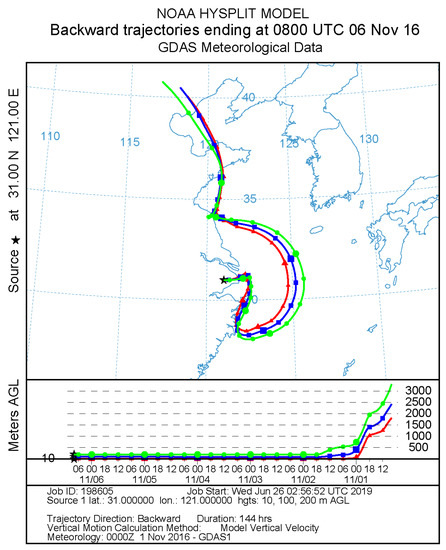
Figure 10.
Simulation of the backward trajectory of pollutant particles. The star represents the location of Shanghai. Different colors represent different heights above ground level (AGL). Red, surface level; blue, 100 m; green, 200 m.
5. Conclusions
We used the objective and quantitative T-PCA circulation classification method to classify the weather in the Shanghai area in the study period into six types. We also divided the local wind fields into three categories (i.e., stagnation, recirculation, and ventilation) based on the AW local horizontal wind field classification method. The wind field characteristics of Shanghai under different circulation patterns were studied. From the perspective of the combination of weather circulation and local wind fields, the effects of multi-scale meteorological conditions on severe haze in the study period in Shanghai were elucidated. The main conclusions were as follows:
In the study period, weather conditions in the Shanghai area do not facilitate particle dispersal. The local wind field was dominated by stagnation and recirculation types, and haze was thus likely to occur.
Through the analysis of the relationships among CTs, local wind fields, and haze conditions, it was found that stagnation and recirculation wind fields often accompanied CT1, CT2, and CT4. At such times, the Shanghai area was most prone to severe haze—the probability of haze occurrence was 41.2%, 35.3%, and 11.8% for CT1, CT2, and CT4, respectively.
The continuous low temperature, low humidity, and northerly wind in the autumn and winter facilitate pollutant dispersal, which directly affected haze events in Shanghai.
Using a severe haze incident in Shanghai in November 2016 as a case study, a simulation of pollutant trajectory using the HYSPLIT model revealed that a severe haze event is likely to be accompanied by recirculation wind fields.
The methodology used in this paper can be easy generalized to other situations and areas, and this type of approach can be used to emit alerts to the population.
Author Contributions
Data curation, J.Z.; Funding acquisition, Y.G.; Methodology, J.Z. and C.L.; Project administration, C.Z.; Resources, Z.Z. (Zeming Zhou); Software, H.D.; Supervision, H.X.; Validation, J.X.; Visualization, H.D.; Writing—original draft, Z.Z. (Zezheng Zhao); Writing—review and editing, A.R. and C.Z.
Funding
This research was funded by [National Key R&D Program of China] grant number [2018YFC0213600], [National Natural Science Foundation Committee of China] grant number [41475021, 41375154 and 41405146] and [Chinese Prime Minister Fund] grant number [DQGG0104].
Acknowledgments
This study was supported by the National Key R&D Program of China (2018YFC0213600), the National Natural Science Foundation Committee of China (41475021, 41375154 and 41405146) and the Chinese Prime Minister Fund (DQGG0104). We thank the authors and developers of the COST733 classification software.
Conflicts of Interest
The authors declare no conflicts of interest
References
- Chan, C.K.; Yao, X. Air pollution in mega cities in China. Atmos. Environ. 2008, 42, 1–42. [Google Scholar] [CrossRef]
- Zhang, Q.H.; Zhang, J.P. The challenge of improving visibility in Beijing. Atmos. Chem. Phys. 2010, 10, 7821–7827. [Google Scholar] [CrossRef]
- Zhang, Y.L.; Cao, F. Fine particulate matter (PM2.5) in China at a city level. Sci. Rep. 2015, 5, 148–184. [Google Scholar] [CrossRef] [PubMed]
- Jacob, D.J.; Winner, D.A. Effect of climate change on air quality. Atmos. Environ. 2009, 43, 51–63. [Google Scholar] [CrossRef]
- Penner, J.P.; Andreae, M. Their Direct and Indirect Effects, in: Climate Change 2001: The Scientific Basis.Contribution of Working Group I to the Third Assessment Report of the Intergovernmental Panel on Climate Change; Cambridge University Press: Cambridge, UK, 2001; pp. 289–348. [Google Scholar]
- Du, E.; Dong, D.; Zeng, X. Direct effect of acid rain on leaf chlorophyll content of terrestrial plants in China. Sci. Total Environ. 2017, 605, 764–769. [Google Scholar] [CrossRef]
- Zhou, C.J.; Wei, G. Effects of potential recirculation on air quality in coastal cities in the Yangtze River Delta. Sci. Total Environ. 2019, 651, 12–23. [Google Scholar] [CrossRef]
- Pope Iii, C.A.; Dockery, D.W. Health effects of fine particulate air pollution: Lines that connect. J. Air Waste Manag. Assoc. 2006, 56, 709–742. [Google Scholar] [CrossRef]
- Chiu, H.F.; Tiao, M.M. Effects of Asian Dust Storm Events on Hospital Admissions for Chronic Obstructive Pulmonary Disease in Taipei, Taiwan. Inhal. Toxicol. 2008, 20, 777–781. [Google Scholar] [CrossRef]
- Krewski, D.; Jerrett, M. Extended Followup and Spatial Analysis of the American Cancer Society Study Linking Particulate Air Pollution and Mortality; HEI Research Report 140; Health Effects Institute: Boston, MA, USA, 2009. [Google Scholar]
- Zhang, J.; Mauzerall, D.L. Environmental health in China: Progress towards clean air and safe water. Lancet 2010, 375, 1110–1119. [Google Scholar] [CrossRef]
- Yu, H.L.; Yang, C.H. Spatial vulnerability under extreme events: A case of Asian dust storm’s effects on children’s respiratory health. Environ. Int. 2013, 54, 35–44. [Google Scholar] [CrossRef]
- Liu, J.; Han, Y. Estimating adult mortality attributable to PM2.5 exposure in China with assimilated PM2.5 concentrations based on a ground monitoring network. Sci. Total Environ. 2016, 568, 1253–1262. [Google Scholar] [CrossRef] [PubMed]
- Kan, H.; Chen, B. Particulate air pollution in urban areas of Shanghai, China: Health-based economic assessment. Sci. Total Environ. 2004, 322, 71–79. [Google Scholar] [CrossRef] [PubMed]
- Huang, K.; Zhuang, G. Typical types and formation mechanisms of haze in an Eastern Asia megacity, Shanghai. Atmos. Chem. Phys. 2012, 12, 105–124. [Google Scholar] [CrossRef]
- Li, J.; Liao, H.; Hu, J.; Li, N. Severe particulate pollution days in China during 2013–2018 and the associated typical weather patterns in Beijing-Tianjin-Hebei and the Yangtze River Delta regions. Environ. Pollut. 2019, 248, 74–81. [Google Scholar] [CrossRef]
- Ma, T.; Duan, F.; He, K.; Qin, Y.; Tong, D.; Geng, G.; Liu, X.; Li, H.; Yang, S.; Ye, S.; et al. Air pollution characteristics and their relationship with emissions and meteorology in the Yangtze River Delta region during 2014–2016. J. Environ. Sci. 2019, 83, 8–20. [Google Scholar] [CrossRef] [PubMed]
- Pan, B.F.; Wang, W. Analysis of the Reason of Formation and the Characteristic of Pollution about Fog or Haze at Key Cities in Autumn and Winter in China. Environ. Sustain. Dev. 2013, 1, 33–36. [Google Scholar]
- Li, K.; Liao, H.; Cai, W.; Yang, Y. Attribution of anthropogenic influence on atmospheric patterns conducive to recent most severe haze over eastern China. Geophys. Res. Lett. 2018, 45, 2072–2081. [Google Scholar] [CrossRef]
- Zhang, L.; Wang, T.; Lv, M.; Zhang, Q. On the severe haze in Beijing during January 2013: Unraveling the effects of meteorological anomalies with WRF-Chem. Atmos. Environ. 2015, 104, 11–21. [Google Scholar] [CrossRef]
- Bei, N.F.; Li, G.H. Typical synoptic situations and their impacts on the wintertime air pollution in the Guanzhong basin in China. Atmos. Chem. Phys. 2016, 16, 7373–7387. [Google Scholar] [CrossRef]
- Zheng, G.J.; Duan, F.K. Exploring the severe winter haze in Beijing: The impact of synoptic weather, regional transport and heterogeneous reactions. Atmos. Chem. Phys. 2015, 15, 2969–2983. [Google Scholar] [CrossRef]
- Paredes, D.; Trigo, R.M. Understanding precipitation changes in Iberia in early spring: Weather typing and storm-tracking approaches. J. Hydrometeorol. 2006, 7, 101–113. [Google Scholar] [CrossRef]
- Lorenzo, M.N.; Taboada, J.J. Links between circulation weather types and teleconnection patterns and their influence on precipitation patterns in Galicia (NW Spain). Int. J. Climatol. 2008, 28, 1493–1505. [Google Scholar] [CrossRef]
- Ramos, A.M.; Barriopedro, D. Circulation weather types as a tool in atmospheric, climate, and environmental research. Front. Environ. Sci. 2015, 3, 44. [Google Scholar] [CrossRef]
- Russo, A.; Trigo, R.M. NO2, PM10 and O3 urban concentrations and its association with circulation weather types in Portugal. Atmos. Environ. 2014, 89, 768–785. [Google Scholar] [CrossRef]
- Ramos, A.M.; Ramos, R. Cloud to ground lightning activity over Portugal and its association with circulation weather types. Atmos. Res. 2011, 101, 84–101. [Google Scholar] [CrossRef]
- Russo, A.C.; Gouveia, C.M. The influence of circulation weather patterns at different spatial scales on drought variability in the Iberian Peninsula. Front. Environ. Sci. 2015, 3, 1. [Google Scholar] [CrossRef]
- Beck, C.; Philipp, A. Evaluation and comparison of circulation type classifications for the European domain. Phys. Chem. Earth Parts A/B/C 2010, 35, 374–387. [Google Scholar] [CrossRef]
- McGregor, G.R.; Bamzelis, D. Synoptic typing and its application to the investigation of weather air pollution relationships, Birmingham, United Kingdom. Theor. Appl. Climatol. 1995, 51, 223–236. [Google Scholar] [CrossRef]
- Jiang, N.; Hay, J.E.; Fisher, G.W. Synoptic weather types and morning rush hour nitrogen oxides concentrations during Auckland winters. Weather Clim. 2005, 25, 43–69. [Google Scholar] [CrossRef]
- Levy, I.; Dayan, U.; Mahrer, Y. Differing atmospheric scales of motion and their impact on air pollutants. Int. J. Climatol. 2010, 30, 612–619. [Google Scholar] [CrossRef]
- The National Centers for Environmental Prediction. Available online: https://www.ncep.noaa.gov (accessed on 25 October 2019).
- The China National Environmental Monitoring Center. Available online: http://www.cnemc.cn (accessed on 25 October 2019).
- Huth, R. An intercomparison of computer-assisted circulation classification methods. Int. J. Climatol. 1996, 16, 893–922. [Google Scholar] [CrossRef]
- Huth, R.; Beck, C. Classifications of atmospheric circulation patterns. Ann. N. Y. Acad. Sci. 2008, 1146, 105–152. [Google Scholar] [CrossRef] [PubMed]
- Huth, R. Properties of the circulation classification scheme based on the rotated principal component analysis. Meteorol. Atmos. Phys. 1996, 59, 217–233. [Google Scholar] [CrossRef]
- Richman, M.B. Obliquely rotated principal components: An improved meteorological map typing technique. J. Appl. Meteorol. 1981, 20, 1145–1159. [Google Scholar] [CrossRef]
- Compagnucci, R.H.; Richman, M.B. Can principal component analysis provide atmospheric circulation or teleconnection patterns? Int. J. Climatol. 2008, 28, 703–726. [Google Scholar] [CrossRef]
- Philipp, A.; Beck, C.; Esteban, P.; Kreienkamp, F.; Krennert, T.; Lochbihler, K.; Lykoudis, S.P.; Pianko-Kluczynska, K.; Post, P.; Alvarez, D.R.; et al. cost733-class-1.2 User Guide; Augsburg, Germany, 2014; pp. 10–21. [Google Scholar]
- The COST733 website. Available online: http://cost733.met.no/ (accessed on 25 October 2019).
- Allwine, K.J.; Whiteman, C.D. Single-station integral measures of atmospheric stagnation, recirculation and ventilation. Atmos. Environ. 1994, 28, 713–721. [Google Scholar] [CrossRef]
- Seagram, A.; Steyn, D.G. Modelled recirculation of pollutants during ozone episodes in the Lower Fraser Valley. In Air Pollution Modelling and its Application XXII; Springer: Dordrecht, The Netherlands, 2012; Volume 49, pp. 291–294. [Google Scholar]
- Surkova, G. Air recirculation and ventilation in the coastal regions of the Black Sea. Open Geosci. 2013, 5, 196–207. [Google Scholar] [CrossRef]
- Levy, I.; Dayan, U.; Mahrer, Y. Studying coastal recirculation with a simplified analytical land-sea breeze model. J. Geophys. Res. Atmos. 2008, 113, 144–156. [Google Scholar] [CrossRef]
- Levy, I.; Dayan, U.; Mahrer, Y. A five-year study of coastal recirculation and its effect on air pollutants over the East Mediterranean region. J. Geophys. Res. Atmos. 2008, 113, 2310–2324. [Google Scholar] [CrossRef]
- Nankar, D.P.; Patra, A.K. Atmospheric stagnation, recirculation and ventilation characteristics at Kakrapar atomic power station site. Ann. Nucl. Energy 2009, 36, 475–480. [Google Scholar] [CrossRef]
- Russo, A.; Gouveia, C. Coastal recirculation potential affecting air pollutants in Portugal: The role of circulation weather types. Atmos. Environ. 2016, 135, 9–19. [Google Scholar] [CrossRef]
- Zhou, C.J.; Wei, G. Effects of synoptic circulation patterns on air quality in Nanjing and its surrounding areas during 2013–2015. Atmos. Pollut. Res. 2018, 9, 723–734. [Google Scholar] [CrossRef]
- Mohan, M.; Bhati, S. Wind flow conditions as an indicator to assimilative capacities of urban airsheds towards atmospheric pollution potential. J. Civ. Environ. Eng. 2013, S1, 1. [Google Scholar] [CrossRef]
- Russo, A.; Gouveia, C.M.; Soares, P.M.M.; Cardoso, R.M.; Mendes, M.T.; Trigo, R.M. The unprecedented 2014 Legionnaires’ disease outbreak in Portugal: atmospheric driving mechanisms. Int. J. Biometeorol. 2018, 11, 1–13. [Google Scholar]
- The HYSPLIT model. Available online: https://www.arl.noaa.gov/hysplit/hysplit (accessed on 25 October 2019).
© 2019 by the authors. Licensee MDPI, Basel, Switzerland. This article is an open access article distributed under the terms and conditions of the Creative Commons Attribution (CC BY) license (http://creativecommons.org/licenses/by/4.0/).